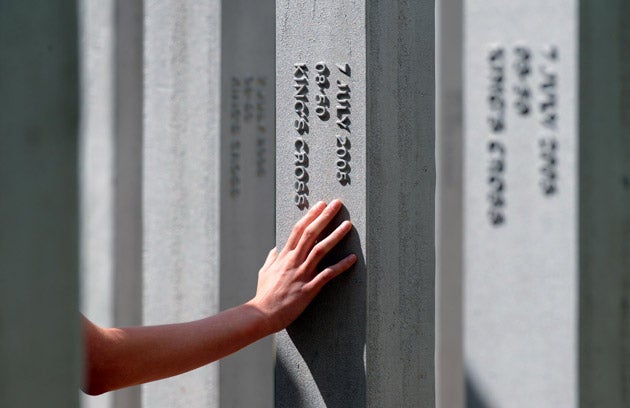Tom Sutcliffe: An open space to remember
The Week In Culture

We wanted it to be user-friendly if you like," said one of those bereaved by the 7/7 bombings, giving an interview to the BBC about the permanent memorial to the dead, which was unveiled in Hyde Park this week. It seemed a slightly odd phrase to use about a solemn monument, but Graham Foulkes's meaning was clear from the context. He wanted people to feel at ease with this object, for children to use it as a playground even, and for it to play a part in the park's continuing life. It seemed a generous sentiment to me, a recognition that not every stranger will bring to this spot the same gravity of feeling as those directly bereaved, and that some will come and treat it simply as a piece of modern sculpture, unaware (until they see the nearby plaque perhaps) that it enshrines great sorrow.
I was most struck by the word "friendly" though, because the aesthetic style of the Hyde Park monument, a kind of Carl Andre minimalism, with 52 virtually identical steel pillars ranked in geometrical lines and bearing only the date and location of the death they marked, isn't one that you would have thought a random selection of the public would have found amiable. Put it in a gallery and I'd guess that a lot of people would find it cold and unyieldingly conceptual, yet in this context it met with what seemed to be unanimous approval.
One explanation for that would be that no informed viewer will struggle with what the concept is. This work isn't taciturn in the way of some contemporary structure because what it's "about" is no mystery. It's about grief and memory, and it leaves the exact elaboration of those ideas to us. But the bigger story is surely that abstraction in sculpture really doesn't cause people problems any more. And you can trace the arc of that story through commemorative sculpture alone. When Edwin Lutyens designed the Cenotaph in 1919 he was attacked from both sides – by modernists who felt he'd compromised on stark simplicity and by traditionalists who wanted something representational, showing noble Tommies. Similar anxieties were in play some 60 years later, when Maya Ying Lin's minimalist design for the Vietnam Veterans Memorial in Washington provoked such controversy that a representational statue of three soldiers was eventually commissioned to appease traditionalists. In both cases modernity caused a problem and solved it simultaneously, enraging more conservative mourners with the absence of conventional narrative (heroic poses, solicitous angels, images of comradeship etc), but doing nothing that would get in the way of whatever story people wanted to bring to the site. Now, perhaps because of the durable success of both those monuments, it seems that stark minimalism simply isn't any longer regarded as a kind of omission of feeling. It's regarded instead as the conventional form of commemorative decorum. Oddly, it has a link with the large poster of Michael Jackson that stood outside the Staples Centre in LA – its empty expanses almost immediately filled with the individual scrawls of fans' farewells. It wasn't the picture that mattered, it was the white space. In a far more permanent way the Hyde Park memorial (and minimalism) leaves open space for mental inscriptions. It's user-friendly.
Dolls not welcome
An intriguing report in The Art Newspaper reveals that the current director of the Hermitage Museum in St Petersburg has banned "traditional" matryoshka dolls from the museum shop on the grounds that they aren't traditional at all, but an idea imported to Russia only in 1890, when a folk painter called Sergei Maliutin was inspired by a set of Japanese dolls to produce his own version. After that, as we would put it now, the idea went viral, and there can be very few visitors to Russia who don't contribute to the economy by buying a set, all broadly convinced that the souvenir they're purchasing has a long Slavic folk-history.
There's no huge mystery as to the appeal of the thing – there's just something deeply satisfying about this kind of recession – but it is surely curious that the Japanese, with their passion for miniaturisation and ingenious containment, didn't capitalise on the appeal first. It also makes me ask two other questions. How many of these hidden aliens are there in world culture? And has anybody produced a fine art equivalent, showing Braque nested inside Boccioni inside Kazemir Malevich and so on?
Surely that would qualify for the Hermitage gift shop.
* I attended one of Artangel's drop-in life classes recently, part of a project that has included Channel Four's series Life Class: Today's Nude (last one today at 12.30pm, when John Berger will be offering his thoughts on life drawing). I wasn't a bit surprised by my incompetence as a draughts-man, but I was a bit surprised at how frustrating I found it, and how disproportionately satisfying it is when something goes right. Our tutor didn't offer much in the way of tips and practical guidance, preferring a rather more numinous approach that was at times so transcendental that I had not a clue what he required of us. But, more usefully, he also insisted at one point that we do a rapid series of full-figure drawings in as little as 10 seconds. The only sketch I could bear to look at without wincing came out of that session, as if the speed of the operation had set aside the possibility of fiasco. Frankly, I felt like David Hockney, though sadly that sensation lasted only as long as it took to produce the drawing itself. A salutory act of self-flagellation for any professional critic though, and a reminder of just how hard it can be to produce something that's even mediocre.
Join our commenting forum
Join thought-provoking conversations, follow other Independent readers and see their replies
Comments
Bookmark popover
Removed from bookmarks